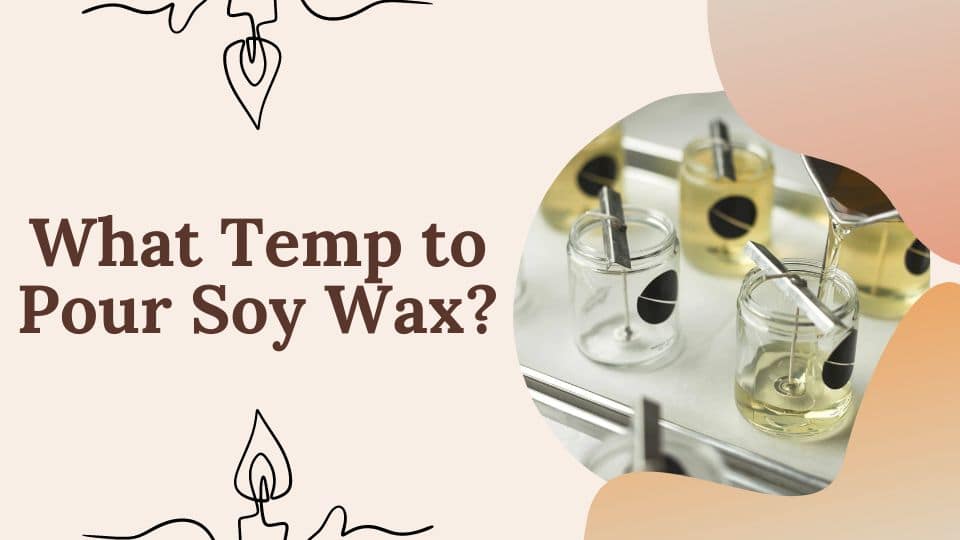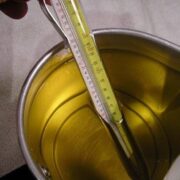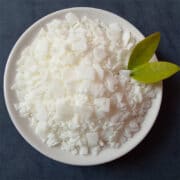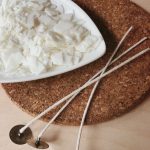
When it comes to the perfect pour temperature for wax, many factors come into play. Soy wax is particularly susceptible to fat bloom if processed outside of a narrow range of cooling conditions.
The ideal environment for pouring soy wax is one with a temperature between 70 and 80 degrees Fahrenheit, and humidity levels between 35 and 50%.
Pouring your candles at this optimal temperature range from 150 to 170 deg F should help avoid fat blooming, as well as other issues such as wetting or discoloration.
You will experience a greater fat bloom if the temperature is higher. Learn what happens if you overheat soy wax in this article.
To achieve this desired outcome when pouring your candles, make sure that the containers you use are either at room temperature or slightly warmer.
This will ensure that the wax does not cool too quickly and cause any cracking or distortion in its shape. Once you have reached your optimal temperate range (120 – 165F), you can start pouring!
As you do so, be mindful that the wax cools quickly due to its low melting point so take care to not overfill!
After the candle has been poured, it should go through a curing process lasting 12 hours before being lit up and enjoyed.
During this curing time period, the crystals within the wax will fully form giving a smooth finish on your candle’s surface when completed.
Taking your time during each step of this process will ensure a successful end product without any problems arising along the way!
The pour point for some popular waxes
For best performance, all soy waxes appear to have comparable ranges of temperatures to heat, add FO, and pour. Most are 185 degrees for melting, 170 degrees for FO, and 140 degrees for pouring.
464 Soy Wax
Crafting the perfect candle requires precision and skill. Begin by heating 464 Soy Wax in a double boiler to 180°F–185°F, then add color and scent for an aromatic finish. To optimize side adhesion in glass containers, warm them up between 100°F–125°F (optional).
Depending on your region’s climate conditions, experiment with pouring temperatures of 125-145 ° F to create candles that sparkle!
444 Soy Wax
- In a double boiler, wax should be heated to between 180°F and 185°F. Mix everything well after adding the color and scent.
- To enhance edge adherence, warm glassware jars to 100°F–125°F. (Extra)
- Pour candles slowly after lowering the temperature to between 125°F–45°F. You may have to play with pouring temps, depending on your location.
415 Soy Wax
Achieve ideal wax temperatures for crafting the perfect candles! Follow a double-boiler setup and heat 415 Soy Wax to 180°F–185°F. Mix in fragrances or dyes at this stage, then precondition glass vessels with temps between 100°F–125°F (optional).
Reduce the temperature once more – down to 90°F to 100 back before pouring your beautiful creations out of their molds. It’s important always remain aware of changing environment conditions when working in various climates – be prepared for anything!
Recommended for all types of wax
- Soak up as much cooling time as you can. Avoid placing it in a water bath or refrigerator to hasten the chilling process.
- Depending on the dye/fragrance mix, different wicks may be required. It has been discovered that this wax works nicely with the CD and ECO wick lines.
Conclusion
To summarize, everything is regulated and optimized in full-scale candle factories to produce excellent candles: containers are heated to the appropriate temperature, cooling takes place at the correct temperature for the exact time, and wax mixing and pouring are done perfectly. When working with soy wax, people who make candles at home should try to get as close as possible to the same level of precision.
In other words, look around, try things out, measure them, and write down what you find until you have a method that works well and is consistent.
Carole Brooks has been making candles for many years. She loves to create candles of all different types and for all different purposes. Here she shares her experience and knowledge. Carole is a graduate of Texas A&M University.






